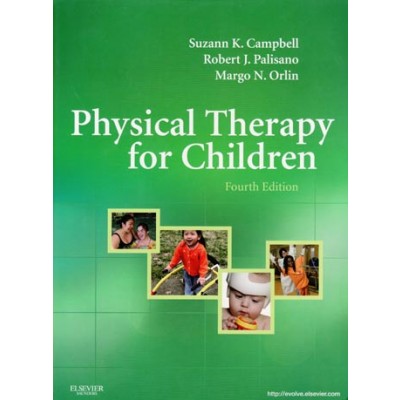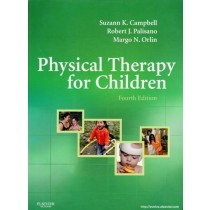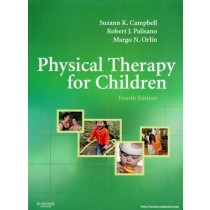
Physical Therapy for Children, 4th Ed: Module 3
SKU: 737
This course is offered in cooperation with Elsevier Science and utilizes the textbook, “Physical Therapy for Children, 4th edition” c2012 by Suzann K. Campbell, PT, PhD, FAPTA.
From the basics of pediatrics to clinical applications, this book presents evidence-based coverage of treatment information in a convenient and concise format. The textbook follows the practice pattern categories of the Guide to Physical Therapist Practice and focuses on the additional information you need to know when treating children.
Module 1 covers the management of musculoskeletal impairments in pediatrics including juvenile idiopathic arthritis, spinal conditions, congenital muscular torticollis, osteogenesis imperfecta, muscular dystrophy, limb deficiencies and amputations, sports injuries in children and more!
Module 2 covers the management of neurologic impairment in pediatrics including developmental coordination disorder, motor and intellectual disabilities, cerebral palsy, brachial plexus injuries, spinal cord injuries, myelodysplasia, traumatic brain injuries, brain tumors and more!
Module 3 covers the management of cardiopulmonary conditions including cystic fibrosis, asthma, thoracic surgery and children requiring long-term mechanical ventilation, the educational environment, the burn unit, the special care nursery and the transition to adulthood for youth with disabilities.
Course Length: 15.0 contact hours
Instructional Level: Intermediate
This package contains the required reading and test materials for Module 3 only.
Physical Therapy for Children, 4th Ed: Module 3
Course Goals: This course is intended to instruct the student through self-paced study on the management of cardiopulmonary complications and special consideration affecting children including a child’s educational environment, assistive technology as it relates to children, child burn victims and special cure nursery considerations.
Student Objectives:
At the end of this course, the student will be able to:
1. Identify the criteria for an individual to be considered a long-term ventilator user
2. Identify 15 clinical signs of respiratory failure
3. Identify the term “chronic respiratory failure”
4. Identify 8 pathophysiologic mechanisms affecting central dysregulation of breathing that can lead to chronic respiratory failure
5. Identify 9 disorders of the lungs, lung parenchyma and airway that can lead to chronic respiratory failure
6. Identify 8 diseases/disorders of the chest wall and thorax that can lead to chronic respiratory failure
7. Identify the selection criteria for mechanical ventilation
8. Identify 6 modes of invasive positive pressure ventilation
9. Identify 20 complications associated with mechanical ventilation
10. Identify activity limitation associated with long-term ventilator assistance
11. Identify elements of patient management for a patient with long-term ventilator assistance
12. Identify the organs and systems commonly affected by cystic fibrosis (CF)
13. Identify pulmonary treatments for CF
14. Identify techniques to measure pulmonary function in a patient with CF
15. Identify evaluation techniques and treatment interventions for children with CF in the infancy period, pre-school and school-age period, adolescence and transition to adulthood
16. Identify benefits of an exercise program to a patient with CF
17. Identify asthma and the medical ramifications of the disease
18. Identify impairments, evaluation techniques and treatment strategies for children with asthma in the infancy period, pre-school and school-age period, adolescence and transition to adulthood
19. Identify the types of cardiopulmonary, neuromuscular, musculoskeletal, integumentary, and gastrointestinal impairments that may be associated with asthma
20. Identify 3 significant characteristics of asthma
21. Identify the clinical classification of the disease severity of asthma
22. Identify 6 diseases associated with heart defects
23. Identify clinical signs of an infant with a congenital heart defect
24. Identify the most common congenital heart defect in children
25. Identify types of congenital heart defects and early therapy issues
26. Identify the primary area to be addressed after heart repair
27. Identify impairments, evaluation techniques and treatment strategies for children with congenital heart disease in the infancy period, pre-school and school-age period, and adolescence
28. Identify recommendations to assist with a Neonatal Intensive Care Unit’s (NICU) attempt to more closely resemble the environment of a mother’s womb
29. Identify 3 pulmonary complications and 2 neurologic complications that can affect a premature infant
30. Identify the major perinatal cause of neurologic morbidity in both the premature and full-term infant
31. Identify causes of neonatal seizures in premature and full-term infants
32. Identify characteristics of newborns with fetal alcohol syndrome and neonatal abstinence syndrome
33. Identify components of the Test of Infant Motor Performance (TIMP)
34. Identify developmental interventions of positioning, sensorimotor stimulation, and oral-motor therapy as they apply to an infant in the NICU
35. Identify key social and political events that led to the enactment of the Education for All Handicapped Children Act
36. Identify key Federal laws and amendments that benefit therapists treating pediatric clients
37. Identify federal definitions of children with disabilities
38. Identify the importance of team interaction when treating children in an educational environment
39. Identify the service delivery model in educational settings
40. Identify factors to consider when determining the intensity and frequency of therapy visits in the educational environment
41. Identify challenges to therapists treating a child in the “least restrictive environment”
42. Identify 5 models of service delivery in the educational environment
43. Identify 7 issues in school-based practice
44. Identify 3 types of burns based on the thickness of the burn
45. Identify the unreliability of the standard “rule of nines” when assessing a burn on children under 15-years of age
46. Identify guidelines for the medical management of burns
47. Identify the optimal donor sites for skin grafts
48. Identify 15 types of alternative wound closure options and topical agents
49. Identify the components of a hypertrophic scar
50. Identify possible musculoskeletal complications when treating a pediatric burn client
51. Identify evaluation guidelines, treatment techniques and guidelines for treating a child with a burn
52. Identify burn treatment options for exercise, positioning, splinting and pressure for a child
53. Identify signs of a poor-fitting or improperly applied splint
54. Identify the difference in effectiveness between static and dynamic splinting
55. Identify exercise goals for burn clients in the emergent, acute and postacute stages of recovery
56. Identify potential impairments from burns to various parts of the body
57. Identify considerations for preparation of youth with disabilities for adult roles
58. Identify obstacles youth may face when considering postsecondary education
59. Identify the role of the therapist in the transition process from youth with disabilities to adulthood
SKU: 737
This course is offered in cooperation with Elsevier Science and utilizes the textbook, “Physical Therapy for Children, 4th edition” c2012 by Suzann K. Campbell, PT, PhD, FAPTA.
From the basics of pediatrics to clinical applications, this book presents evidence-based coverage of treatment information in a convenient and concise format. The textbook follows the practice pattern categories of the Guide to Physical Therapist Practice and focuses on the additional information you need to know when treating children.
Module 1 covers the management of musculoskeletal impairments in pediatrics including juvenile idiopathic arthritis, spinal conditions, congenital muscular torticollis, osteogenesis imperfecta, muscular dystrophy, limb deficiencies and amputations, sports injuries in children and more!
Module 2 covers the management of neurologic impairment in pediatrics including developmental coordination disorder, motor and intellectual disabilities, cerebral palsy, brachial plexus injuries, spinal cord injuries, myelodysplasia, traumatic brain injuries, brain tumors and more!
Module 3 covers the management of cardiopulmonary conditions including cystic fibrosis, asthma, thoracic surgery and children requiring long-term mechanical ventilation, the educational environment, the burn unit, the special care nursery and the transition to adulthood for youth with disabilities.
Course Length: 15.0 contact hours
Instructional Level: Intermediate
This package contains the required reading and test materials for Module 3 only.
Physical Therapy for Children, 4th Ed: Module 3
Course Goals: This course is intended to instruct the student through self-paced study on the management of cardiopulmonary complications and special consideration affecting children including a child’s educational environment, assistive technology as it relates to children, child burn victims and special cure nursery considerations.
Student Objectives:
At the end of this course, the student will be able to:
1. Identify the criteria for an individual to be considered a long-term ventilator user
2. Identify 15 clinical signs of respiratory failure
3. Identify the term “chronic respiratory failure”
4. Identify 8 pathophysiologic mechanisms affecting central dysregulation of breathing that can lead to chronic respiratory failure
5. Identify 9 disorders of the lungs, lung parenchyma and airway that can lead to chronic respiratory failure
6. Identify 8 diseases/disorders of the chest wall and thorax that can lead to chronic respiratory failure
7. Identify the selection criteria for mechanical ventilation
8. Identify 6 modes of invasive positive pressure ventilation
9. Identify 20 complications associated with mechanical ventilation
10. Identify activity limitation associated with long-term ventilator assistance
11. Identify elements of patient management for a patient with long-term ventilator assistance
12. Identify the organs and systems commonly affected by cystic fibrosis (CF)
13. Identify pulmonary treatments for CF
14. Identify techniques to measure pulmonary function in a patient with CF
15. Identify evaluation techniques and treatment interventions for children with CF in the infancy period, pre-school and school-age period, adolescence and transition to adulthood
16. Identify benefits of an exercise program to a patient with CF
17. Identify asthma and the medical ramifications of the disease
18. Identify impairments, evaluation techniques and treatment strategies for children with asthma in the infancy period, pre-school and school-age period, adolescence and transition to adulthood
19. Identify the types of cardiopulmonary, neuromuscular, musculoskeletal, integumentary, and gastrointestinal impairments that may be associated with asthma
20. Identify 3 significant characteristics of asthma
21. Identify the clinical classification of the disease severity of asthma
22. Identify 6 diseases associated with heart defects
23. Identify clinical signs of an infant with a congenital heart defect
24. Identify the most common congenital heart defect in children
25. Identify types of congenital heart defects and early therapy issues
26. Identify the primary area to be addressed after heart repair
27. Identify impairments, evaluation techniques and treatment strategies for children with congenital heart disease in the infancy period, pre-school and school-age period, and adolescence
28. Identify recommendations to assist with a Neonatal Intensive Care Unit’s (NICU) attempt to more closely resemble the environment of a mother’s womb
29. Identify 3 pulmonary complications and 2 neurologic complications that can affect a premature infant
30. Identify the major perinatal cause of neurologic morbidity in both the premature and full-term infant
31. Identify causes of neonatal seizures in premature and full-term infants
32. Identify characteristics of newborns with fetal alcohol syndrome and neonatal abstinence syndrome
33. Identify components of the Test of Infant Motor Performance (TIMP)
34. Identify developmental interventions of positioning, sensorimotor stimulation, and oral-motor therapy as they apply to an infant in the NICU
35. Identify key social and political events that led to the enactment of the Education for All Handicapped Children Act
36. Identify key Federal laws and amendments that benefit therapists treating pediatric clients
37. Identify federal definitions of children with disabilities
38. Identify the importance of team interaction when treating children in an educational environment
39. Identify the service delivery model in educational settings
40. Identify factors to consider when determining the intensity and frequency of therapy visits in the educational environment
41. Identify challenges to therapists treating a child in the “least restrictive environment”
42. Identify 5 models of service delivery in the educational environment
43. Identify 7 issues in school-based practice
44. Identify 3 types of burns based on the thickness of the burn
45. Identify the unreliability of the standard “rule of nines” when assessing a burn on children under 15-years of age
46. Identify guidelines for the medical management of burns
47. Identify the optimal donor sites for skin grafts
48. Identify 15 types of alternative wound closure options and topical agents
49. Identify the components of a hypertrophic scar
50. Identify possible musculoskeletal complications when treating a pediatric burn client
51. Identify evaluation guidelines, treatment techniques and guidelines for treating a child with a burn
52. Identify burn treatment options for exercise, positioning, splinting and pressure for a child
53. Identify signs of a poor-fitting or improperly applied splint
54. Identify the difference in effectiveness between static and dynamic splinting
55. Identify exercise goals for burn clients in the emergent, acute and postacute stages of recovery
56. Identify potential impairments from burns to various parts of the body
57. Identify considerations for preparation of youth with disabilities for adult roles
58. Identify obstacles youth may face when considering postsecondary education
59. Identify the role of the therapist in the transition process from youth with disabilities to adulthood





